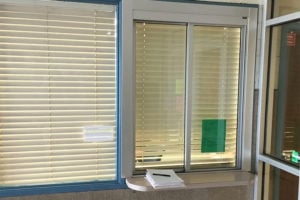The ideal mantrap is like a filter: it passes everyone who belongs and blocks anyone who might cause harm. To accomplish this, the building funnels visitors into the mantrap one at a time. They first pass through exterior doors (often by providing some low-level credential, like entering a code on a PIN pad or scanning an ID). This gives them access to a narrow, video-monitored, secured passage. The doors at the other end are locked, blast-proof, and bulletproof. Once the exterior door latches, the visitor can present additional credentials (e.g., pass a security check, submit biometrics, undergo a scan for threats). If he or she comes up clean, the interior secure doors open automatically. Those who fail the scan cannot pass into the facility—or leave the monitored passage—until security arrives.
Such “movie mantraps” are one-piece integrated turn-key units. It’s a set-and-forget, fully automated, drop-in-place solution that needs no monitoring, has zero maintenance, creates zero false positives, and never lets an attacker slip through.
But in the real world, it’s neither this easy nor this “one-size-fits-all.”
Mantrap Benefits and Strengths
Regardless of design, mantraps have many benefits. They are among the best ways to restrict movement in and out of any secure facility. First and foremost, they allow for “physical multi-factor authentication” since gaining entry requires more than just stealing a keycard, learning a PIN, or tailgating a legitimate visitor. In order to pass a mantrap, you’ll need both the code for the door and to pass an ID check, biometric confirmation, answer questions via a video intercom, or the like.
Mantraps also lend themselves to creating good security bottlenecks. In addition to making it easier to keep out potential threats, this also makes it much easier to create and maintain a comprehensive building log and audit trail for each staff member or guest. You know who entered when, via what authentications and interactions, and in many cases can even piece together the duration of their stay.
In the case of a security incident, such information is obviously invaluable. But it is extremely helpful on a daily basis as well. These logs can be used to verify timesheets, track down lost deliveries, confirm the building has been fully evacuated in an emergency, or guide rescue workers trying to locate those who didn’t make it out.
But they are not without their drawbacks.
Mantrap Costs and Failings
First and foremost, prefabricated mantraps are expensive. Even a basic “steel phonebooth” mantrap starts in the $10,000 to $30,000 range (before installation). Most organizations looking for something even slightly larger or more attractive can expect to pay up to $60,000, just for the base units.
Second—but often a larger stumbling block—is that these are prefabricated. They come in manufacturer-specified physical configurations with a limited range of access control or monitoring options. Unless you are very lucky or build your security around the mantrap, then it is unlikely a prefabricated mantrap will seamlessly mesh with your building aesthetic and existing access control or monitoring systems. In most cases, you’ll need to renovate in order to accommodate the mantrap itself or its supporting systems (mechanicals, wire runs, etc.)
Additionally, prefabricated mantraps may create issues with ADA compliance, local fire codes, and life-safety expectations. A UK-based company producing high-quality prefabricated mantraps is unlikely to be fully cognizant of and compliant with fire code and accessibility requirements in Cambridge, MA, or Burbank, CA.
Finally, fully automated “set-and-forget” mantrap solutions are frustratingly prone to false positives.
For more information download our Bulletproof Systems Component Guide
False Positives
Sam Tuohey (a financial services COO in California) offers a textbook example of mantrap false positive issues:
I worked for an institution that put a “man trap” in the entrance of its main branch. …
The problem with this technology was a high number of “false positives.” The man trap we bought couldn’t tell a Glock from a roll of quarters, so it went off a lot, locking in members who wanted to exchange their piggy banks for cash. …
One day, a real-life bad guy came into this branch. He made it through the mantrap with no problem. He didn’t have a gun or any weapon. He was there to cash some forged cashier’s checks at our teller window. The teller immediately spotted the bad checks and knew that the man was a crook, so she used our internal messaging system to advise the branch manager that the fraud was happening right there and then. The manager quickly called the police from her office.
The police were nearby and showed up within a few minutes. The two officers walked very quickly through the first door of the man trap, but not so much through the second door. The man trap detected the guns and locked the cops in. They started banging on the door and yelling to be let out, which the teller did pretty quickly. The con artist saw and heard the commotion that the police were making and he bolted out the fire door in the rear of the building.
We got rid of the man trap shortly thereafter.
Mantrap vs. Secure Vestibule
Jim Richards, CEO of Total Security Solutions, has been crafting custom physical security solutions for decades. “In many cases,” he explains, “people are looking for a ‘mantrap’ as a pre-made set-in-place unit. That’s not usually our approach. And, in many cases, not the right solution.”

Adapting a school vestibule to function as a mantrap
Years ago TSS pioneered “secure vestibule” renovation. This is where a bulletproofing company like TSS modifies and hardens an existing building vestibule to act as a mantrap. Secure vestibules began as a school security solution, where buildings traditionally not at all designed for access control needed a cost-effective way to convert their facilities to allow for security checks for visitors. Secure vestibule solutions have since caught on in many other areas, especially city offices and corporate headquarters.
“We do a lot of lobby work for corporations that functionally approximate the mantrap. This, then, is the first line of defense: by limiting access to who is allowed in and how they enter. Depending on the level of protection such a solution will usually range from $25,000 to $45,000 [as of mid-2021].”
Importantly, that price is for a fully custom, fully installed solution—not a single pre-made component that you then need to install at your own expense.
Custom Mantrap Solutions
Customization is the true value of the secure vestibule. A custom secure vestibule builds off of your existing structure and seamlessly integrates with your aesthetics and systems. Your secure vestibule can work with a guard, directly integrate a metal detector, or vastly increase the effectiveness of video (as you can position people as you choose in a constrained space with good lighting). It might include detection systems for environmental hazards or explosives. It might include a COVID check.
“These are really incredibly flexible systems,” says Eric Malzahn, a Total Security Solutions project manager. “With such powerful systems, it’s really important to get all the details right, all the parts meshing. What separates TSS is that we’re willing to work with other security vendors as equals. Other companies in our industry really shy away from that. They don’t understand access control, so they don’t want to deal with it. We’re not scared of these types of challenges. We’ll customize our systems to make it work however the end-user wants. We always take the time to research it and work with others to make it happen.”


